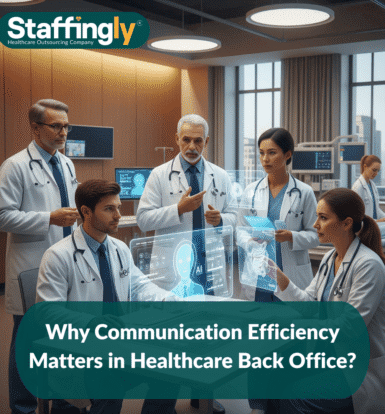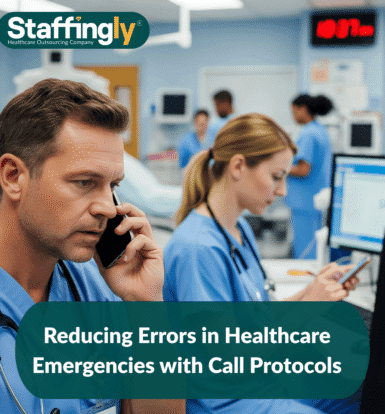On-Demand Outsourcing BPO Services for Healthcare Providers With 24/7 Coverage!
Save up to 70% on staffing costs!
Browse Specialty Staffing Services
Why Communication Efficiency Matters in Healthcare Back Office?
In healthcare, the back office acts as the engine room it keeps patient records accurate, ensures timely claim submissions, and enables smooth data flow between providers, payers, and patients. However, that engine began to stall due to one major bottleneck: fragmented communication. Phones rang nonstop. Sticky notes piled up. Voicemails, emails, and hallway conversations scattered critical information across multiple channels. These distractions didn’t just waste time they undermined accuracy, slowed efficiency, and drained staff morale. Thankfully, that’s beginning to change.

Improving Patient Care Through Missed Call Alerts in Healthcare
In Today’s Healthcare Environment… Time is precious, accuracy is non-negotiable, and communication gaps don’t just cost patience they compromise care quality. A single missed call can result in delayed care, missed follow-ups, or billing complications. When you rely on real-time communication to keep patient care flowing, every call matters. Every moment spent chasing down voicemails or wondering if a patient ever called back adds up. But what if you didn’t have to wait for someone to flag a missed interaction?

Agents Knew Our Specialty No More Explaining Terms Twice
In today’s healthcare environment, time is precious, accuracy is non-negotiable, and communication gaps don’t just cost patience they compromise care quality. Every moment spent explaining a term like “1:1 supervision” or “TAR” to someone who should already understand it steals time from patients, disrupts workflows, and increases the cognitive load on already overstretched teams. But what if you never had to explain those terms again?What if your virtual agents understood your clinical language, processes, and patient priorities from day one

How Custom Data Exports Optimize Healthcare Operations
At a fast-growing urgent care network in Denver, Colorado, operations director Kevin Malone had a recurring challenge: “We had data tons of it but no easy way to extract, filter, or analyze what mattered most. Every report request meant chasing down IT or digging through fragmented dashboards.” The clinic’s goal was clear: improve performance, spot trends, and optimize care delivery using real-time communication data. But without exportable call logs, messaging analytics, or triage response metrics, decision-making was delayed and reactive.

Improving Healthcare Communication with Multilingual Support
At a busy pediatric clinic in Los Angeles, California, practice manager Ana Rodriguez vividly recalls the challenges her team faced when serving a diverse patient population. “We have families speaking Spanish, Mandarin, Tagalog, and more,” she explains. “Every day, we ran into barriers that slowed down care and frustrated both staff and patients.” Miscommunication wasn’t just inconvenient it was risky. Missed instructions led to no-show appointments, improper medication use, and delays in care. For a clinic dedicated to serving its

Structured Call Handling Enhances Healthcare Patient Experience
At a large primary care network in Dallas, Texas, operations manager Rebecca Liu shares a surprising reality: “Patients aren’t just satisfied they actually thank our agents for handling their calls. That’s not something you hear often in healthcare.” What changed? The answer lies in structured call handling and empathetic communication powered by Staffingly, Inc. When patients feel heard, respected, and guided clearly, even challenging calls turn into positive experiences. The Problem: Calls Were Frustrating and Fragmented Healthcare phone systems have

Reducing Errors in Healthcare Emergencies with Call Protocols
A Common Emergency Breakdown At a regional urgent care facility in Charlotte, North Carolina, the administrative lead Sarah Wells recalls the chaos of real emergency calls. “Staff froze. People forgot key questions. Every second felt like an hour,” she explains. Despite regular training, emergencies were unpredictable—and staff members were overwhelmed. Calls about seizures, chest pain, child injuries, or medication overdoses required speed, clarity, and calm. But instead, clinics found themselves stuck in hesitation loops, making panicked calls or fumbling through

How Secure SMS Follow-ups Improve Healthcare Communication?
“We Stopped Chasing Calls and Patients Finally Responded” Dr. Emily Carter runs a bustling internal medicine clinic in Austin, Texas. Her clinic serves hundreds of patients every week, and her mission has always been clear: spend more time caring for patients, less time on red tape. But one thing consumed her staff’s energy: the endless phone calls. “We’d call patients about lab results, appointment reminders, or postvisit instructions and nine times out of ten, we’d hit voicemail,” Dr. Carter recalls.
 Book a Demo to Build Your Team Today!
Book a Demo to Build Your Team Today!


 Read Case Studies
Read Case Studies 


 Virtual Medical Assistants
Virtual Medical Assistants



